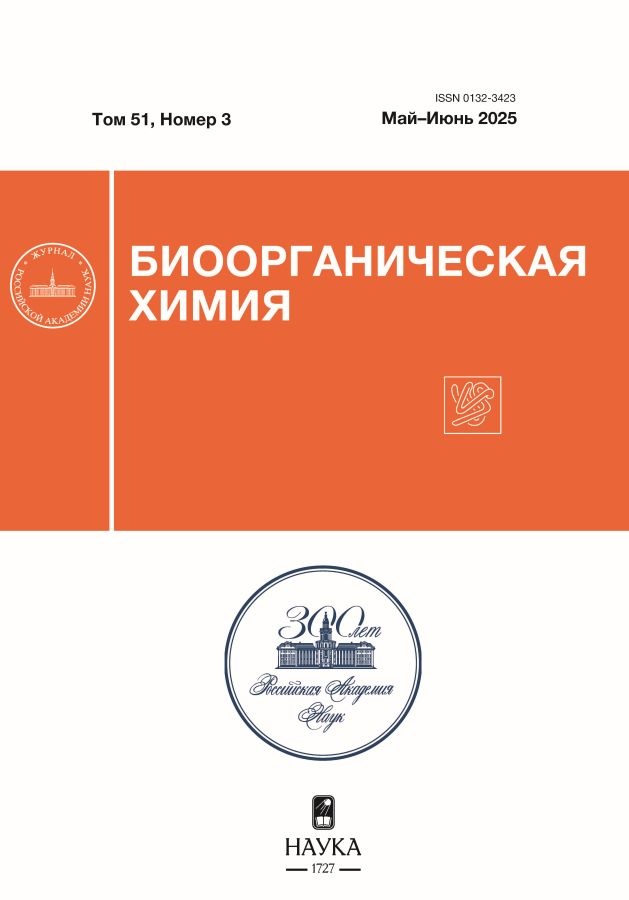Regulation of pou5f3 family pluripotency gene transcripts stability by Ybx1 ribonucleoprotein complexes in Xenopus laevis early development
- Autores: Parshina Е.А.1, Zaraisky A.G.1, Martynova N.Y.1
-
Afiliações:
- Shemyakin–Ovchinnikov Institute of Bioorganic Chemistry of the Russian Academy of Sciences
- Edição: Volume 51, Nº 3 (2025)
- Páginas: 486-495
- Seção: ОБЗОРНАЯ СТАТЬЯ
- URL: https://rjmseer.com/0132-3423/article/view/686997
- DOI: https://doi.org/10.31857/S0132342325030113
- EDN: https://elibrary.ru/KRCMXF
- ID: 686997
Citar
Texto integral
Resumo
Here, we studied the regulation of pou5f3 family transcripts stability by association with Ybx1, a protein of ribonucleoprotein complexes. It is known that the clawed frog Xenopus laevis has three genes belonging to the POU5 family: pou5f3.1/oct91, pou5f3.2/oct25, and pou5f3.3/oct60. The Pou5f3 family factors are orthologues of the mammalian embryonic stem cell OCT4 pluripotency factor. However, the expression patterns of these genes differ over time. Pou5f3.3/oct60 transcripts are stored in oocytes, are present in large quantities in fertilized eggs, and then degrade only after fertilization. Pou5f3.2/oct25 transcripts are also present in the zygote, but their numbers increase even more during the development process. Finally, pou5f3.1/oct91 transcription begins only after the activation of the embryo genome at the middle blastula stage. In the present work, we revealed a much higher specificity of the Ybx1 factor to form a complex with the maternal mRNA of the pou5f3.3/oct60 gene compared to zygotic mRNAs of the pou5f3.1/oct91 and pou5f3.2/oct25 genes. Since Ybx1 is a protein that, on the one hand, is involved in interaction with cytoskeletal proteins, and, on the other hand, binds and stabilizes pluripotency genes mRNA, it can play a linking role in between the degradation of these maternal transcripts and cytoskeletal rearrangements during the onset of morphogenetic cell movements in the process of formation of germ layers.
Palavras-chave
Texto integral
Sobre autores
Е. Parshina
Shemyakin–Ovchinnikov Institute of Bioorganic Chemistry of the Russian Academy of Sciences
Email: martnat61@gmail.com
Rússia, ul. Miklukho-Maklaya 16/10, Moscow, 117997
A. Zaraisky
Shemyakin–Ovchinnikov Institute of Bioorganic Chemistry of the Russian Academy of Sciences
Email: martnat61@gmail.com
Rússia, ul. Miklukho-Maklaya 16/10, Moscow, 117997ul. Miklukho-Maklaya 16/10, Moscow, 117997
N. Martynova
Shemyakin–Ovchinnikov Institute of Bioorganic Chemistry of the Russian Academy of Sciences
Autor responsável pela correspondência
Email: martnat61@gmail.com
Rússia, ul. Miklukho-Maklaya 16/10, Moscow, 117997
Bibliografia
- Onichtchouk D. // Biochimica et Biophysica Acta. 2016. V. 1859. P. 770–779. https://doi.org/10.1016/j.bbagrm.2016.03.013
- Gold D.A., Gates R.D., Jacobs D.K. // Mol. Biol. Evol. 2014. V. 31. P. 3136–3147. https://doi.org/10.1093/molbev/msu243
- Rosner M.H., Vigano M.A., Ozato K., Timmons P.M., Poirier F., Rigby P.W., Staudt L.M. // Nature. 1990. V. 345. P. 686-692. https://doi.org/10.1038/345686a0
- Downs K.M. // Dev Dyn. 2008. V. 237. P. 464–475. https://doi.org/10.1002/dvdy.21438
- Morichika K., Sugimoto M., Yasuda K., Kinoshita T. // Zygote. 2014. V. 22. P. 266-274. https://doi.org/10.1017/S0967199412000536
- Hinkley C.S., Martin J.F., Leibham D., Perry M. // Mol. Cell. Biol. 1992. V. 12. P.638–649. https://doi.org/10.1128/mcb.12.2.638-649.1992
- Cao Y., Knochel S., Donow C., Miethe J., Kaufmann E., Knochel W. // J. Biol. Chem. 2004. V. 279. P. 43735– 43743. https://doi.org/10.1074/jbc.M407544200
- Cao Y., Siegel D., Knöchel W. // Mech Dev. 2006. V. 123. P. 614–625. https://doi.org/10.1016/j.mod.2006.06.004
- Cao Y., Siegel D., Donow C., Knöchel S., Yuan L., Knöchel W. // EMBO J. 2007. V. 26. P. 2942–2954. https://doi.org/10.1038/sj.emboj.7601736
- Parshina E.A., Zaraisky A.G., Martynova N.Yu. // Bioorg. Chem. 2020. V. 46. P. 1–10. https://doi.org/10.2139/ssrn.3554017
- Jacobson A., Peltz,S.W. // Ann. Rev. Biochem. 1996. V. 65. P. 693–739. https://doi.org/10.1146/annurev.bi.65.070196.003401
- Evdokimova V.M., Ovchinnikov L.P. // Int. J. Biochem. Cell. Biol. 1999. V. 31. P. 139–149. https://doi.org/10.1016/s1357-2725(98)00137-x
- Evdokimova V., Ruzanov P., Imataka H., Raught B., Svitkin Y., Ovchinnikov L.P., Sonenberg N. // EMBO J. 2001. V. 20. P. 5491–5502. https://doi.org/10.1093/emboj/20.19.5491
- Bouvet P., Matsumoto K., Wolffe A.P. // J. Biol. Chem. 1995. V. 270. P. 28297–28303. https://doi.org/10.1074/jbc.270.47.28297
- Eliseeva I.A., Kim E.R., Guryanov S.G., Ovchinnikov L.P., Lyabin D.N. // Biochemistry (Moscow). 2011. V. 76. P. 1402–1433. https://doi.org/10.1134/S0006297911130049.
- Parshina E.A., Eroshkin F.M., Оrlov E.E., Gyoeva F.K., Shokhina A.G., Staroverov D.B., Belousov V.V., Zhigalova N.A., Prokhortchouk E.B., Zaraisky A.G., Martynova N.Y. // Cell. Rep. 2020. V. 33. P. 108396. https://doi.org/10.1016/j.celrep.2020.108396
- Martynova N.Y., Parshina E.A., Zaraisky A.G. // STAR Protocols. 2021. V. 2. P. 100552. https://doi.org/10.1016/j.xpro.2021.100552
- Livigni А., Peradziryi H., Sharov A.A., Chia G., Hammachi F., Portero Migueles R.P., Sukparangsi W., Pernagallo S., Bradley M., Nichols J., Ko M.S.H., Brickman J.M. // Curr. Biol. 2013. V. 23 P. 2233– 2244. https://doi.org/10.1016/j.cub.2013.09.048
- Ruzanov P.V., Evdokimova V.M., Korneeva N.L., Hershey J.W., Ovchinnikov L.P. // J Cell Sci. 1999. V. 112. P. 3487–3496. https://doi.org/10.1242/jcs.112.20.3487
- Martynova N.Y., Parshina E.A., Eroshkin F.M., Zaraisky A.G. // Russ. J. Bioorg. Chem. 2020. V. 46. P. 530–536. https://doi.org/10.1134/S1068162020040147
- Livak K.J., Schmittgen T.D. // Methods. 2001. V. 25. P. 402–408. https://doi.org/10.1006/meth.2001.1262
- Ivanova A.S., Korotkova D.D., Martynova N.Y., Averyanova O.V., Zaraisky A.G., Tereshina M.B. // Russ. J. Bioorg. Chem. 2018. V. 44. P. 358–361. https://doi.org/10.1134/S106816201803007X
Arquivos suplementares












